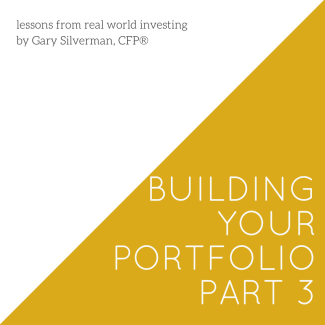
Portfolio Building: What's Rebalancing got to do With It?
By Gary Silverman, CFP®
There are many ways to invest your money. There are different investment types, different ways to invest in those types, different strategies for managing the investments, and different tactics for moving things around. For this discussion, I’m going to consider two viable ways to handle your investments: buy-and-hold and rebalancing.
Buy-and-hold is pretty self-explanatory. You buy an investment and you keep it until you need to turn it into cash to spend. This is a lazy person’s dream. It also works out pretty well. After all, if you don’t do anything in-between buying and selling, it’s hard to make many mistakes.
That said there are two main problems with buy-and-hold strategy. First, companies change, and many don’t last 30 years. This can be fixed easily. Instead of investing in individual companies, you invest in mutual funds or exchange-traded funds. That way you get a mix of securities in one nice wrapper and if something needs to be replaced, someone else does it for you.
The other problem with buy-and-hold (and in my opinion, the one that matters most) is that the portfolio can get out of balance. For example, let’s say you put half of your money in a mutual fund that invests in stocks and it earns an average of 10% a year. You put the other half of your money in a mutual fund that invests in bonds and it earns 6% a year. So at the start you have a 50-50 stock-bond split.
Thirty years go by. You’re now approaching retirement. Looking at your portfolio, you find that you have about a quarter of your money in bonds. Your 50-50 split became 75-25 …stocks are now over three-quarters of your portfolio. Over the years stocks grew more than bonds, so your portfolio got riskier—exactly the opposite of what most retirees want.
Rebalancing, well, rebalances things. You might rebalance once a year, once a quarter, or even every day. Rebalancing gets rid of the biggest problem that buy-and-hold has: your portfolio getting unbalanced. In the previous example, the portfolio would have been driven back to its original 50-50 split by rebalancing.
How do you do this? Simple: You sell off enough of the investment that is now over-weighted and use the proceeds to buy the one that’s a bit short.
However, there is a psychological problem with this. If you were rebalancing once a year back in the late ‘90s you would have been selling off stocks during a bull market. Many people in that position would say to themselves, “Self, why would I want to sell down my stocks which are doing well and buy bonds with the proceeds? I should instead sell some bonds and buy stocks with the money.”
Or consider this. In late 2008, you would have looked at your portfolio and seen that stocks lost about half their value. How likely are you to sell off some of your nice, safe bonds and buy some of those evil risky stocks?
Good questions. And we’ll answer them next week.
Gary Silverman, CFP® is the founder of Personal Money Planning, LLC, a Wichita Falls retirement planning and investment management firm and author of Real World Investing.

